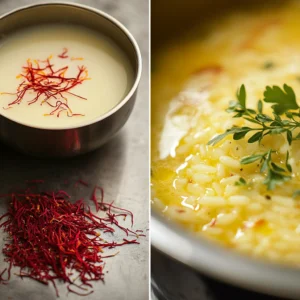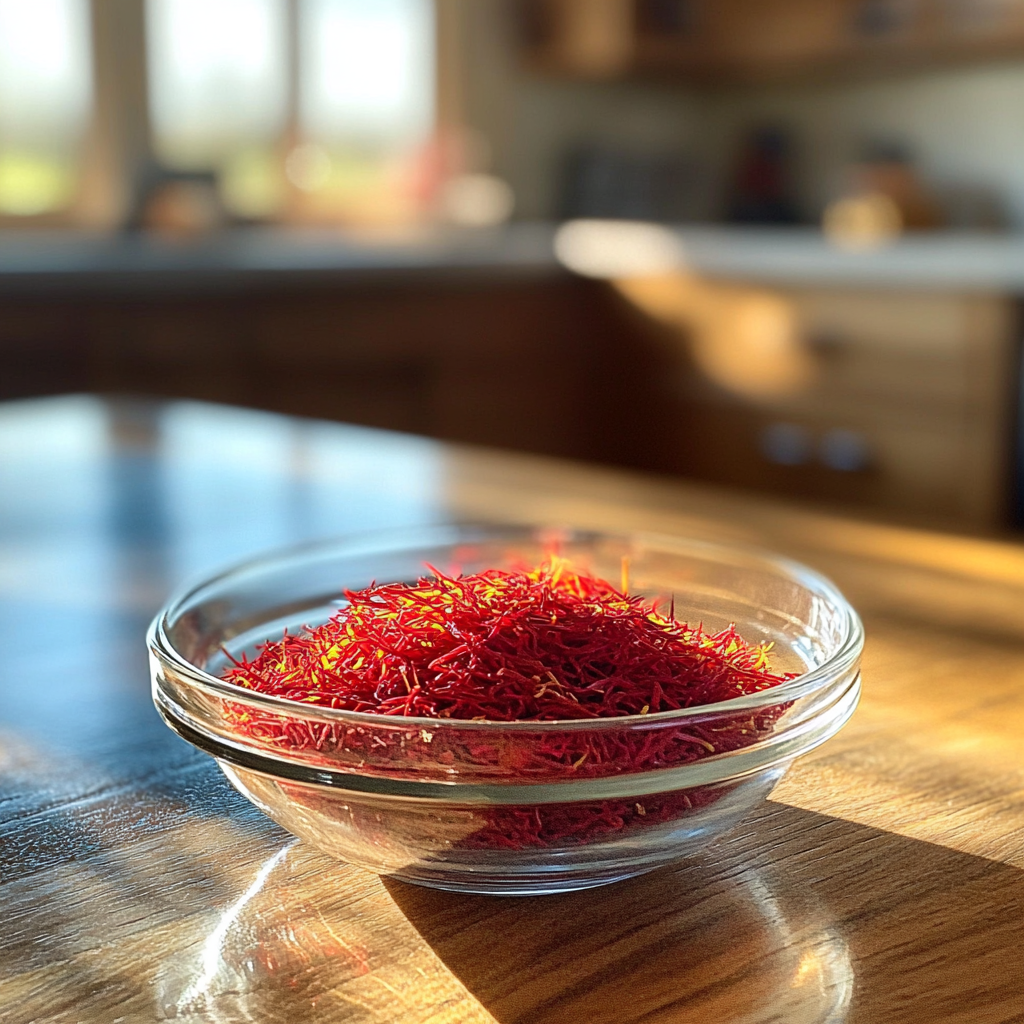Saffron recipes hold a special place in culinary traditions across the globe. Known as the most expensive spice in the world, saffron is prized for its distinct flavor, vibrant color, and unique aroma. Whether you’re looking to add a touch of luxury to your everyday meals or preparing for a special occasion, saffron can transform an ordinary dish into a gastronomic delight. In this comprehensive guide, we’ll explore the diverse ways saffron is used in cooking and provide a collection of saffron recipes that span the world’s culinary boundaries.
From savory dishes like saffron rice to sweet creations like saffron ice cream, saffron is a versatile spice that lends itself to a wide range of preparations. If you’re new to cooking with saffron, this article will provide everything you need to know, from how to use saffron effectively in your dishes to understanding its health benefits and cultural significance.
What is Saffron?

Saffron is derived from the stigma of the Crocus sativus flower, and its vibrant red threads are carefully harvested by hand. Each flower produces only three threads of saffron, making the spice incredibly labor-intensive to produce. In fact, it takes over 75,000 flowers to yield just one pound of saffron, which contributes to its high cost. The threads are then dried and used in cooking, infusing dishes with their characteristic golden color and earthy, floral flavor.
Saffron has been used in cooking and as a medicinal plant for thousands of years. Historically, it was reserved for the wealthy and used as a luxury item in ancient civilizations such as Greece, Rome, and Persia. Today, saffron continues to be a highly sought-after spice used in a variety of saffron recipes across different cultures, including Mediterranean, Middle Eastern, and South Asian cuisines.
Saffron’s rich color and flavor make it ideal for adding visual appeal and complexity to dishes. It imparts a delicate, slightly sweet flavor that’s often described as floral and earthy, with a hint of bitterness when used in excess. It pairs well with a wide range of ingredients, including seafood, poultry, rice, and desserts.
For more details on the role of saffron in global cuisines and to discover some great saffron recipes, check out Food & Wine’s collection of saffron recipes. Explore the recipes here.
Health Benefits of Saffron
While saffron is primarily used for its culinary properties, it also boasts a variety of health benefits. This precious spice is rich in antioxidants, which can help protect the body from oxidative stress and free radical damage. Here are some key health benefits associated with saffron:
Rich in Antioxidants
Saffron contains several powerful antioxidants, such as crocin, crocetin, and safranal. These antioxidants help neutralize free radicals in the body, which can cause cell damage and contribute to chronic diseases like heart disease, cancer, and neurodegenerative disorders.
Mood Improvement
Saffron has long been used as a natural remedy for depression and anxiety. Studies have shown that saffron can have mood-lifting effects, helping to alleviate symptoms of mild to moderate depression. It’s thought to work by increasing serotonin levels in the brain, a neurotransmitter responsible for regulating mood.
Anti-inflammatory Effects
The compounds in saffron are known for their anti-inflammatory properties, which can help reduce inflammation in the body. This makes saffron beneficial for individuals suffering from inflammatory conditions like arthritis, Crohn’s disease, and asthma.
Digestive Health
Saffron has been used traditionally to improve digestion and treat digestive issues such as bloating, gas, and indigestion. It can help stimulate the production of digestive enzymes, promoting better digestion.
Improved Cognitive Function
Some studies suggest that saffron may help improve memory and cognitive function, which could potentially aid in the treatment of Alzheimer’s disease and other neurodegenerative disorders.
Incorporating saffron into your cooking with saffron recipes not only adds an elegant flavor to your dishes but also provides these health benefits, making it a valuable ingredient to include in your diet.
For more information on how saffron can improve your health, explore BBC Good Food’s collection of saffron recipes, which highlights the versatility of saffron in nutritious meals. Read more about saffron here.
For more information on saffron’s health benefits, including its mood-boosting and antioxidant properties, check out this article on Healthline here
Selecting and Storing Saffron
When using saffron in your saffron recipes, it’s important to select high-quality saffron and store it properly to ensure maximum flavor and potency. Here are some tips for selecting and storing saffron:
Selecting Saffron
- Look for deep red threads: The best saffron has vibrant, deep red threads. Saffron that is pale yellow or orange may be of lower quality or may be mixed with other substances.
- Whole threads are preferred: Whole saffron threads tend to have a stronger flavor and aroma than powdered saffron, so opt for whole threads whenever possible.
- Check for authenticity: Due to saffron’s high price, there are many counterfeit or diluted versions available. Be sure to purchase saffron from reputable sources to ensure its authenticity and quality.
Storing Saffron
- Airtight container: To preserve saffron’s essential oils and potent aroma, store it in an airtight container, such as a small glass jar.
- Cool, dry place: Store saffron in a cool, dry place away from light and moisture. A dark cupboard or pantry is ideal.
- Use within six months: While saffron doesn’t spoil quickly, it loses its potency over time. To ensure the best flavor and aroma, use saffron within six months of purchasing it.
Now that you understand how to select and store saffron, let’s take a closer look at how to incorporate it into your cooking.
Saffron in Global Cuisines
Saffron is a beloved ingredient in many global cuisines, from the rich, savory dishes of the Mediterranean to the sweet treats of South Asia. Let’s explore some of the regions where saffron is used most frequently and discover how to incorporate saffron into your own saffron recipes.
1. Middle Eastern Cuisine
Saffron plays a central role in Middle Eastern cooking, where it is used in dishes like lamb tagine, pilaf, and kebabs. It pairs wonderfully with rich meats, nuts, and dried fruits, creating complex and aromatic flavors. In addition to its use in savory dishes, saffron is often found in Middle Eastern sweets, such as baklava and ma’amoul.
2. Mediterranean Cuisine

In Mediterranean countries like Spain and Italy, saffron is used to flavor iconic dishes such as paella and risotto. These dishes highlight saffron’s ability to add both flavor and color to rice-based meals. In Spain, saffron is essential for creating the deep golden hue of traditional paella and is often paired with seafood, meats, and vegetables. If you’re looking to explore more vibrant and flavorful recipes, check out this ultimate Tajin recipe guide for inspiration.
3. South Asian Cuisine
In South Asia, saffron is used extensively in dishes like biryani, a fragrant rice dish with spices, and kulfi, a creamy frozen dessert. Saffron is also added to gulab jamun, a sweet Indian dessert made from fried dough soaked in syrup. In addition to savory dishes, saffron is often used to flavor dairy-based desserts, making it a staple in Indian and Pakistani cuisine.
Saffron’s versatility across different cuisines makes it a perfect ingredient to experiment with in your own saffron recipes.
Techniques for Cooking with Saffron

Saffron is a delicate spice, and its flavor can be easily lost if not handled properly. Here are some tips and techniques for using saffron in your saffron recipes:
1. Infusing Saffron
To get the most out of saffron, it’s important to infuse it in liquid before adding it to your dishes. This ensures that the threads release their full flavor and color. Soak saffron in a small amount of warm water, broth, or milk for about 10–15 minutes before incorporating it into your recipe.
2. Adding Saffron to Dishes
Once saffron is infused, add it to your dishes during the cooking process. For rice dishes like saffron rice or paella, add the saffron-infused liquid to the pot along with the rice. For stews and soups, add saffron early on in the cooking process to allow its flavor to develop.
3. Using Saffron with Dairy
Saffron pairs wonderfully with dairy, which helps to mellow its flavor. Infuse saffron in warm milk or cream to make rich desserts like saffron ice cream or saffron panna cotta. The creaminess of the dairy helps balance the saffron’s floral notes, creating a harmonious flavor profile.
Popular Saffron Recipes
Now that we’ve discussed how to use saffron, let’s explore some popular saffron recipes that showcase its versatility.

Aromatic Saffron Rice
Equipment
- Saucepan
Ingredients
- 1 cup basmati rice
- 1/4 teaspoon saffron threads
- 1 1/2 cups water or broth
- 1 tablespoon olive oil
- salt to taste
- 1 tablespoon lemon juice
Instructions
- Soak the saffron threads in warm water for 15 minutes.
- Rinse the rice thoroughly under cold water.
- In a saucepan, bring the water or broth to a boil. Add the saffron infusion.
- Stir in the rice and cook on low heat for 15–20 minutes, until the rice is tender.
- Fluff the rice with a fork and drizzle with olive oil and lemon juice. Serve as a side dish.
Notes
Saffron Risotto
A classic Italian dish, saffron risotto is creamy, rich, and bursting with flavor. This dish highlights saffron’s ability to elevate a simple ingredient like rice into a luxurious meal.
Ingredients:
- 1 cup Arborio rice
- 1/2 teaspoon saffron threads
- 1 cup white wine
- 4 cups chicken or vegetable broth
- 1/2 cup Parmesan cheese
- 1/2 onion, chopped
- 2 tablespoons butter
Preparation:
- Soak the saffron in warm broth for about 10 minutes.
- In a large pan, melt the butter and sauté the chopped onion until translucent.
- Add the rice and cook for 1–2 minutes, stirring to coat the rice in the butter.
- Gradually add the saffron-infused broth, stirring continuously until the rice absorbs the liquid.
- Continue adding broth, one ladle at a time, until the rice is cooked to your liking.
- Stir in the Parmesan cheese and serve hot.
Saffron Ice Cream (Bastani Irani)
This Persian dessert is infused with saffron and rosewater, creating a luxurious frozen treat.
Ingredients:
- 1 cup milk
- 1/2 cup heavy cream
- 1/4 cup sugar
- 1/4 teaspoon saffron threads
- 1 tablespoon rosewater
- 1/4 cup chopped pistachios
Preparation:
- Infuse saffron in warm milk for 10 minutes.
- Mix the milk, heavy cream, and sugar in a bowl. Stir until the sugar dissolves.
- Add the saffron milk and rosewater to the mixture.
- Pour the mixture into an ice cream maker and churn until set.
- Once the ice cream is ready, stir in the chopped pistachios and freeze until firm.
Frequently Asked Questions about saffron recipes
1. How do I use saffron in cooking?
To use saffron in cooking, soak the threads in warm water, broth, or milk for 10–15 minutes. Add the saffron infusion to your dishes for vibrant color and enhanced flavor.
2. Can saffron be used in both sweet and savory dishes?
Yes, saffron is versatile and can be used in both sweet and savory dishes. It is commonly found in risotto, rice dishes, steaks, as well as in desserts like ice cream and custards.
3. What are some easy saffron recipes for beginners?
Beginner-friendly recipes with saffron include saffron rice, saffron panna cotta, and saffron-infused desserts like ice cream and custards.
4. How do I store saffron to maintain its potency?
Store saffron in an airtight container in a cool, dry place, away from light and moisture. For the best flavor, try to use saffron within six months.
5. Are there any substitutes for saffron in recipes?
While there’s no perfect substitute for saffron’s unique flavor, turmeric or paprika can mimic the color in some dishes, though the flavor will be different.

